Gamma-ray Spectroscopy in Low-Power Nuclear Research Reactors
Abstract
1. Introduction
2. Materials and Methods
2.1. The CROCUS Reactor
2.2. The OSURR
2.3. Overview of Detectors
2.3.1. Inorganic Scintillator: Cerium Bromide (CeBr3)
2.3.2. Semi-Conductor: High-Purity Germanium (HPGe)
2.3.3. Organic Scintillator: Trans-Stilbene (C14H12)
2.3.4. Organic Scintillator: Organic Glass Scintillator (OGS)
2.4. Calibration
2.4.1. Peak Fitting Algorithm (Inorganic Detectors)
2.4.2. Inorganic Detectors
2.4.3. Organic Detectors
3. Results
3.1. HPGe Spectroscopy
3.2. CeBr3 (CROCUS and OSURR)
Acquisition Tests at Criticality
3.3. Organic Detectors (OSURR)
4. Discussion
4.1. Peak Identification
4.2. Organic Scintillator Detectors in Nuclear Reactors
4.2.1. Scintillation Crystal Volume
4.2.2. Prospects of OGS
5. Conclusions
Author Contributions
Funding
Data Availability Statement
Acknowledgments
Conflicts of Interest
Appendix A
| Reactor | Detector | Power | Counts/s (n/) | Counts/W (n/) |
|---|---|---|---|---|
| OSURR | CeBr3 1 in | 10 W | 0/435 | 0/16101 |
| Stilbene 2 in | 10 W | 251/567 | 25.1/56.7 | |
| OGS 1 in | 10 W | 146/307 | 14.6/30.7 | |
| CROCUS | CeBr3 1.3 cm | Shutdown | 0/11475 | n/a |
| HPGe | Shutdown | 0/1793 | n/a |
| Energy (keV) | |||
|---|---|---|---|
| 314 | 572 | 811 | 1135 |
| 332 | 619 | 874 | 1143 |
| 422 | 635 | 918 | 1173 |
| 431 | 639 | 1084 | 1290 |
| 656 | 1296 | 1371 | 1435 |
| 738 | 1371 | 1383 | 1443 |
| 742 | 1398 | 1398 | 1460 |
| 750 | 1435 | 1499 | 1738 |
| 776 | 1443 | 1738 | 1800 |
| 1828 | 1837 | 1922 | |
References
- Colombier, A.-C.; Amharrak, H.; Fourmentel, D.; Ravaux, S.; Régnier, D.; Gueton, O.; Hudelot, J.-P.; Lemaire, M. Nuclear data production, calculation and measurement: A global overview of the gamma heating issue. EPJ Web Conf. 2013, 42, 04001. [Google Scholar] [CrossRef]
- Ródenas, J. Application of the Monte Carlo method to estimate doses due to neutron activation of different materials in a nuclear reactor. Radiat. Phys. Chem. 2017, 140, 442–446. [Google Scholar] [CrossRef]
- Eade, T.; Colling, B.; Naish, J.; Packer, L.; Valentine, A. Shutdown dose rate benchmarking using modern particle transport codes. Nucl. Fusion 2020, 60, 056024. [Google Scholar] [CrossRef]
- Zinkle, S.; Was, G. Materials challenges in nuclear energy. Acta Mater. 2013, 61, 735–758. [Google Scholar] [CrossRef]
- Amharrak, H.; Di Salvo, J.; Lyoussi, A.; Roche, A.; Masson-Fauchier, M.; Bosq, J.; Carette, M. Analysis and recent advances in gamma heating measurements in MINERVE facility by using TLD and OSLD techniques. In Proceedings of the 2011 2nd International Conference on Advancements in Nuclear Instrumentation, Measurement Methods and their Applications, Ghent, Belgium, 6–9 June 2011; pp. 1–9. [Google Scholar]
- Žerovnik, G.; Kaiba, T.; Radulović, V.; Jazbec, A.; Rupnik, S.; Barbot, L.; Fourmentel, D.; Snoj, L. Validation of the neutron and gamma fields in the JSI TRIGA reactor using in-core fission and ionization chambers. Appl. Radiat. Isot. 2015, 96, 27–35. [Google Scholar] [CrossRef] [PubMed]
- Anders, O. Experiences with the Ge(Li) detector for high-resolution gamma ray spectrometry and a practical approach to the pulse pileup problem. Nucl. Instrum. Methods 1969, 68, 205–208. [Google Scholar] [CrossRef]
- Nakashima, Y.; Minato, S.; Kawano, M.; Tsujimoto, T.; Katsurayama, K. Gamma-ray Energy Spectra Observed around a Nuclear Reactor. J. Radiat. Res. 1971, 12, 138–147. [Google Scholar] [CrossRef]
- Houtzeel, A.; Dyer, F. Study of Fission Products in the Molten-Salt Reactor Experiment by Gamma Spectrometry; Technical Report; Oak Ridge National Laboratory (ORNL): Oak Ridge, TN, USA, 1972. [Google Scholar]
- Kovacevic, B.; Soares, A.V.; Lintereur, A.T.; Walters, W.J.; Betzler, B.; Dion, M.P.; Evans, L.G.; Johnsen, A.M. Gamma-ray Signatures for Identifying Plutonium Diversion in Molten Salt Reactors. J. Nucl. Mater. Manag. 2023, 50, 17–34. [Google Scholar]
- Hellesen, C.; Grape, S.; Jansson, P.; Svärd, S.J.; Lindell, M.Å.; Andersson, P. Nuclear spent fuel parameter determination using multivariate analysis of fission product gamma spectra. Ann. Nucl. Energy 2017, 110, 886–895. [Google Scholar] [CrossRef]
- Kim, S.; Martoff, C.J.; Dion, M.; Glasgow, D. Reactor Antineutrino Spectral “Bump”: Cumulative Fission Yields of Irradiated U-235 and Pu-239 Measured by HPGe Gamma-ray Spectroscopy. arXiv 2023, arXiv:2308.05630. [Google Scholar] [CrossRef]
- Stewart, C.; Abou-Jaoude, A.; Erickson, A. Employing antineutrino detectors to safeguard future nuclear reactors from diversions. Nat. Commun. 2019, 10, 3527. [Google Scholar] [CrossRef] [PubMed]
- Molnar, G. Handbook of Prompt Gamma Activation Analysis: With Neutron Beams; Springer Science & Business Media: Berlin/Heidelberg, Germany, 2004; Volume 1. [Google Scholar]
- Lindstrom, R.M.; Révay, Z. Prompt gamma neutron activation analysis (PGAA): Recent developments and applications. J. Radioanal. Nucl. Chem. 2017, 314, 843–858. [Google Scholar] [CrossRef]
- Tian, K.V.; Festa, G.; Szentmiklósi, L.; Maróti, B.; Arcidiacono, L.; Laganà, G.; Andreani, C.; Licoccia, S.; Senesi, R.; Cozza, P. Compositional studies of functional orthodontic archwires using prompt-gamma activation analysis at a pulsed neutron source. J. Anal. At. Spectrom. 2017, 32, 1420–1427. [Google Scholar] [CrossRef]
- Leppänen, J.; Valtavirta, V.; Rintala, A.; Hovi, V.; Tuominen, R.; Peltonen, J.; Hirvensalo, M.; Dorval, E.; Lauranto, U.; Komu, R. Current Status and On-Going Development of VTT’s Kraken Core Physics Computational Framework. Energies 2022, 15, 876. [Google Scholar] [CrossRef]
- Kaltiaisenaho, T. Photon transport physics in Serpent 2 Monte Carlo code. Comput. Phys. Commun. 2020, 252, 107143. [Google Scholar] [CrossRef]
- White, M.C. Development and Implementation of Photonuclear Cross-Section Data for Mutually Coupled Neutron-Photon Transport Calculations in the Monte Carlo N-Particle (MCNP) Radiation Transport Code. Ph.D. Thesis, University of Florida, Gainesville, FL, USA, 2000. [Google Scholar] [CrossRef][Green Version]
- Alqahtani, M. On-line measurement and simulation of the in-core gamma energy deposition in the McMaster nuclear reactor. Nucl. Eng. Technol. 2022, 54, 30–35. [Google Scholar] [CrossRef]
- Miller, E.C.; Clarke, S.D.; Flaska, M.; Prasad, S.; Pozzi, S.A.; Padovani, E. MCNPX-PoliMi post-processing algorithm for detector response simulations. J. Nucl. Mater. Manag. 2012, 40, 34–41. [Google Scholar]
- Kalinowski, M.B.; Pistner, C. Isotopic signature of atmospheric xenon released from light water reactors. J. Environ. Radioact. 2006, 88, 215–235. [Google Scholar] [CrossRef]
- Locatelli, G.; Bingham, C.; Mancini, M. Small modular reactors: A comprehensive overview of their economics and strategic aspects. Prog. Nucl. Energy 2014, 73, 75–85. [Google Scholar] [CrossRef]
- Cooper, M. Small modular reactors and the future of nuclear power in the United States. Energy Res. Soc. Sci. 2014, 3, 161–177. [Google Scholar] [CrossRef]
- Locatelli, G.; Mancini, M.; Todeschini, N. Generation IV nuclear reactors: Current status and future prospects. Energy Policy 2013, 61, 1503–1520. [Google Scholar] [CrossRef]
- Bess, J.D.; Ivanova, T.; Hill, I.; Martin, J.F.; Briggs, J.B.; Scott, L.; DeHart, M.D.; Percher, C.; Marshall, B.J.; Blaise, P. Intrinsic value of the international benchmark projects, ICSBEP and IRPhEP, for advanced reactor development. Front. Energy Res. 2023, 11, 1085788. [Google Scholar] [CrossRef]
- Kodeli, I.A.; Sartori, E. SINBAD—Radiation shielding benchmark experiments. Ann. Nucl. Energy 2021, 159, 108254. [Google Scholar] [CrossRef]
- He, Y.; Petryk, M.; Liu, Z.; Chica, D.G.; Hadar, I.; Leak, C.; Ke, W.; Spanopoulos, I.; Lin, W.; Chung, D.Y.; et al. CsPbBr3 perovskite detectors with 1.4% energy resolution for high-energy γ-rays. Nat. Photonics 2021, 15, 36–42. [Google Scholar] [CrossRef]
- Carchon, R.; Moeslinger, M.; Bourva, L.; Bass, C.; Zendel, M. Gamma radiation detectors for safeguards applications. Nucl. Instruments Methods Phys. Res. Sect. A Accel. Spectrometers Detect. Assoc. Equip. 2007, 579, 380–383. [Google Scholar] [CrossRef]
- Darby, F.B.; Hua, M.Y.; Pakari, O.V.; Clarke, S.D.; Pozzi, S.A. Multiplicity counting using organic scintillators to distinguish neutron sources: An advanced teaching laboratory. Am. J. Phys. 2023, 91, 936–945. [Google Scholar] [CrossRef]
- Warburton, W.K.; Carlson, J.S.; Feng, P.L. Organic glass scintillator (OGS) property comparisons to Stilbene, EJ-276 and BC-404. Nucl. Instruments Methods Phys. Res. Sect. A Accel. Spectrometers Detect. Assoc. Equip. 2021, 1018, 165778. [Google Scholar] [CrossRef]
- Lamirand, V.; Laureau, A.; Pakari, O.; Frajtag, P.; Pautz, A. Power calibration methodology at the CROCUS reactor. EPJ Web Conf. 2020, 225, 04022. [Google Scholar] [CrossRef]
- Kauffman, A.; White, S.; Herminghuysen, K. OSU Nuclear Reactor Laboratory Website. Available online: https://reactor.osu.edu (accessed on 8 November 2023).
- Paratte, J.; Früh, R.; Kasemeyer, U.; Kalugin, M.; Timm, W.; Chawla, R. A benchmark on the calculation of kinetic parameters based on reactivity effect experiments in the CROCUS reactor. Ann. Nucl. Energy 2006, 33, 739–748. [Google Scholar] [CrossRef]
- Bisbee, M.G.; Oksuz, I.; VanZile, M.P.; Cherepy, N.J.; Cao, L.R. An automated fast neutron computed tomography instrument with on-line focusing for non-destructive evaluation. Rev. Sci. Instrum. 2022, 93, 113702. [Google Scholar] [CrossRef]
- ASTM E261-16(2021); Standard Practice for Determining Neutron Fluence, Fluence Rate, and Spectra by Radioactivation Techniques. ASTM: West Conshohocken, PA, USA, 2021; Volume 12.02, pp. 1–15. [CrossRef]
- Jacobs, G.J.; van den Bosch, R.L. Calibration measurements with the multisphere method and neutron spectrum analyses using the SAND-II program. Nucl. Instrum. Methods 1980, 175, 483–489. [Google Scholar] [CrossRef]
- Perey, F. Least-Squares Dosimetry Unfolding: The Program STAY’SL; Technical Report; Oak Ridge National Laboratory: Oak Ridge, TN, USA, 1977. [Google Scholar]
- Kim, C.; Lee, W.; Melis, A.; Elmughrabi, A.; Lee, K.; Park, C.; Yeom, J.Y. A review of inorganic scintillation crystals for extreme environments. Crystals 2021, 11, 669. [Google Scholar] [CrossRef]
- Pakari, O.; Lamirand, V.; Mager, T.; Laureau, A.; Frajtag, P.; Pautz, A. First in-core gamma spectroscopy experiments in a zero power reactor. EPJ Web Conf. 2021, 253, 04022. [Google Scholar] [CrossRef]
- Swiderski, L.; Gojska, A.; Grodzicka, M.; Korolczuk, S.; Mianowski, S.; Moszynski, M.; Rzadkiewicz, J.; Sibczynski, P.; Syntfeld-Kazuch, A.; Szawlowski, M.; et al. Scintillators For High-Temperature Plasma Diagnostics. In Proceedings of the 1st EPS Conference on Plasma Diagnostics—PoS(ECPD2015), Rome, Italy, 14–17 April 2016. [Google Scholar] [CrossRef]
- Billnert, R.; Oberstedt, S.; Andreotti, E.; Hult, M.; Marissens, G.; Oberstedt, A. New information on the characteristics of 1 in.× 1 in. cerium bromide scintillation detectors. Nucl. Instrum. Methods Phys. Res. Sect. A Accel. Spectrometers Detect. Assoc. Equip. 2011, 647, 94–99. [Google Scholar] [CrossRef]
- Peyres, V.; Crespo, T.; Mejuto, M.; García-Toraño, E. Measurement of NORM samples with CeBr3 detectors. Appl. Radiat. Isot. 2017, 126, 307–310. [Google Scholar] [CrossRef] [PubMed]
- Perez-Andujar, A.; Pibida, L. Performance of CdTe, HPGe and NaI(Tl) detectors for radioactivity measurements. Appl. Radiat. Isot. 2004, 60, 41–47. [Google Scholar] [CrossRef] [PubMed]
- Borrel, V.; Kandel, B.; Albernhe, F.; Frabel, P.; Cordier, B.; Tauzin, G.; Crespin, S.; Coszach, R.; Denis, J.; Leleux, P. Fast neutron-induced damage in INTEGRAL n-type HPGe detectors. Nucl. Instrum. Methods Phys. Res. Sect. A Accel. Spectrometers Detect. Assoc. Equip. 1999, 430, 348–362. [Google Scholar] [CrossRef]
- GenieTM Spectroscopy Software Suite, Version 4.0; Mirion Technologies: Atlanta, GA, USA, 2023. Available online: https://www.mirion.com/products/technologies/spectroscopy-scientific-analysis/gamma-spectroscopy/gamma-spectroscopy-software/lab-applications/genie-spectroscopy-software-suite (accessed on 21 December 2023).
- Zaitseva, N.; Glenn, A.; Carman, L.; Martinez, H.P.; Hatarik, R.; Klapper, H.; Payne, S. Scintillation properties of solution-grown trans-stilbene single crystals. Nucl. Instrum. Methods Phys. Res. Sect. A Accel. Spectrometers Detect. Assoc. Equip. 2015, 789, 8–15. [Google Scholar] [CrossRef]
- Beaumont, J.S.; Mellor, M.P.; Villa, M.; Joyce, M.J. High-intensity power-resolved radiation imaging of an operational nuclear reactor. Nat. Commun. 2015, 6, 8592. [Google Scholar] [CrossRef]
- Lopez, R.; Steinberger, W.; Giha, N.; Marleau, P.; Clarke, S.; Pozzi, S. Neutron and gamma imaging using an organic glass scintillator handheld dual particle imager. Nucl. Instrum. Methods Phys. Res. Sect. A Accel. Spectrometers Detect. Assoc. Equip. 2022, 1042, 167407. [Google Scholar] [CrossRef]
- Pakari, O.; Lopez, R.; Druckman, I.; Meng, E.; Zhou, E.; Wang, Z.; Clarke, S.D.; Pozzi, S.A. Real-time mixed reality display of dual particle radiation detector data. Sci. Rep. 2023, 13, 362. [Google Scholar] [CrossRef]
- Carlson, J.S.; Marleau, P.; Zarkesh, R.A.; Feng, P.L. Taking Advantage of Disorder: Small-Molecule Organic Glasses for Radiation Detection and Particle Discrimination. J. Am. Chem. Soc. 2017, 139, 9621–9626. [Google Scholar] [CrossRef] [PubMed]
- Giha, N.P.; Steinberger, W.M.; Nguyen, L.Q.; Carlson, J.S.; Feng, P.L.; Clarke, S.D.; Pozzi, S.A. Organic glass scintillator bars with dual-ended readout. Nucl. Instrum. Methods Phys. Res. Sect. A Accel. Spectrometers Detect. Assoc. Equip. 2021, 1014, 165676. [Google Scholar] [CrossRef]
- Blueshift Optics. Organic Glass Scintillator Product. Available online: https://blueshiftoptics.com/org-glass-scintillator (accessed on 21 December 2023).
- Clark, L.M.; Maurer, T.E.; Marin, S.; Giha, N.P.; Clarke, S.D.; Pozzi, S.A. Time and Energy Resolution of Organic Glass Scintillators for Radionuclide Monitoring. In Proceedings of the 2021 IEEE Nuclear Science Symposium and Medical Imaging Conference (NSS/MIC), Virtual, 16–23 October 2021; pp. 1–4. [Google Scholar]
- Helmer, R.; Heath, R.; Putnam, M.; Gipson, D. Photopeak analysis program for photon energy and intensity determinations: Ge (Li) and NaI (Tl) spectrometers. Nucl. Instrum. Methods 1967, 57, 46–57. [Google Scholar] [CrossRef]
- Routti, J.T.; Prussin, S.G. Photopeak method for the computer analysis of gamma-ray spectra from semiconductor detectors. Nucl. Instrum. Methods 1969, 72, 125–142. [Google Scholar] [CrossRef]
- Virtanen, P.; Gommers, R.; Oliphant, T.E.; Haberland, M.; Reddy, T.; Cournapeau, D.; Burovski, E.; Peterson, P.; Weckesser, W.; Bright, J.; et al. SciPy 1.0: Fundamental algorithms for scientific computing in Python. Nat. Methods 2020, 17, 261–272. [Google Scholar] [CrossRef] [PubMed]
- Harris, C.R.; Millman, K.J.; van der Walt, S.J.; Gommers, R.; Virtanen, P.; Cournapeau, D.; Wieser, E.; Taylor, J.; Berg, S.; Smith, N.J.; et al. Array programming with NumPy. Nature 2020, 585, 357–362. [Google Scholar] [CrossRef] [PubMed]
- Knoll, G.F. Radiation Detection and Measurement; Wiley: New York, NY, USA, 1989. Available online: https://nla.gov.au/nla.cat-vn179294 (accessed on 21 December 2023).
- Norsworthy, M.A.; Poitrasson-Rivière, A.; Ruch, M.L.; Clarke, S.D.; Pozzi, S.A. Evaluation of neutron light output response functions in EJ-309 organic scintillators. Nucl. Instrum. Methods Phys. Res. Sect. A Accel. Spectrometers Detect. Assoc. Equip. 2017, 842, 20–27. [Google Scholar] [CrossRef]
- Clark, D. U235: A Gamma ray Analysis Code for Uranium Isotopic Determination; Technical Report; USDOE: Washington, DC, USA, 1997. [Google Scholar] [CrossRef][Green Version]
- Saraf, B. Energy Levels of Rh 103 from the Decay of Pd 103 and Ru 103. Phys. Rev. 1955, 97, 715. [Google Scholar] [CrossRef]
- Firestone, R.B.; Shirley, V.S.; Baglin, C.M.; Chu, S.Y.; Zipkin, J. The 8th Edition of the Table of Isotopes; Wiley: New York, NY, USA, 1997. [Google Scholar]
- Lin, C.; Chao, J. Chapter 17—Radiochemistry of Iodine: Relevance to Health and Disease. In Comprehensive Handbook of Iodine; Preedy, V.R., Burrow, G.N., Watson, R., Eds.; Academic Press: San Diego, CA, USA, 2009; pp. 171–182. [Google Scholar] [CrossRef]
- Mukhopadhyay, S. MSIPP-NSSTC Course on Gamma ray Spectroscopy—Part IV; Technical Report; USDOE National Nuclear Security Administration (NNSA), Office of Defense Programs (DP): Washington, DC, USA, 2023. [Google Scholar]
- Blachot, J. Nuclear Data Sheets for A = 117. Nucl. Data Sheets 2002, 95, 679–836. [Google Scholar] [CrossRef]
- Fasching, J.L.; Walters, W.B.; Coryell, C.D. Decay of 284-Day 144Ce, 17.3-min 144Pr, and a New Isomer, 7.2-min 144mPr. Phys. Rev. C 1970, 1, 1126–1131. [Google Scholar] [CrossRef]
- Bé, M.M.; Chisté, V.; Dulieu, C.; Kellett, M.; Mougeot, X.; Arinc, A.; Chechev, V.; Kuzmenko, N.; Kibédi, T.; Luca, A.; et al. Table of Radionuclides; Monographie BIPM-5; Bureau International des Poids et Mesures: Saint-Cloud, France, 2016; Volume 8. [Google Scholar]
- Henry, E. Nuclear data sheets for A = 135. Nucl. Data Sheets 1975, 14, 191–245. [Google Scholar] [CrossRef]
- Adams, J.; Carboneau, M. National Low-Level Waste Management Program Radionuclide Report Series—Volume 2, Niobium-94; Technical Report; Lockheed Idaho Technologies Co.: Idaho Falls, ID, USA, 1995. [Google Scholar]
- Boggs, J.V. Gamma-ray Spectra of Fission Products from U235 as a Function of Time after Fission. Ph.D Thesis, The University of Oklahoma, Norman, OK, USA, 1966. [Google Scholar]
- Zheltonozhskaya, M.; Zheltonozhsky, V.; Lykova, E.; Chernyaev, A.; Iatsenko, V. Production of Zirconium-89 by photonuclear reactions. Nucl. Instrum. Methods Phys. Res. Sect. B Accel. Spectrometers Detect. Assoc. Equip. 2020, 470, 38–41. [Google Scholar] [CrossRef]
- Kaur, R.; Sharma, A.K.; Sooch, S.S.; Trehan, P.N. Level Structure of 140Ce from the Decay of 140La. J. Phys. Soc. Jpn. 1980, 49, 2122–2128. [Google Scholar] [CrossRef]
- Yücel, H.; Çetiner, M.; Demirel, H. Use of the 1001 keV peak of 234 mPa daughter of 238U in measurement of uranium concentration by HPGe gamma-ray spectrometry. Nucl. Instrum. Methods Phys. Res. Sect. A Accel. Spectrometers Detect. Assoc. Equip. 1998, 413, 74–82. [Google Scholar] [CrossRef]
- IAEA. Database of Prompt Gamma rays from Slow Neutron Capture for Elemental Analysis; Non-serial Publications; International Atomic Energy Agency: Vienna, Austria, 2007. [Google Scholar]
- United States Environmental Protection Agency. High Resolution Gamma-ray Spectrometry Analyses for Normal Operations and Radiological Incident Response; United States Environmental Protection Agency: Washington, DC, USA, 2019. [Google Scholar]
- Schmidt, H.H.; Hungerford, P.; Daniel, H.; von Egidy, T.; Kerr, S.A.; Brissot, R.; Barreau, G.; Börner, H.G.; Hofmeyr, C.; Lieb, K.P. Levels and gamma energies of 28Al studied by thermal neutron capture. Phys. Rev. C 1982, 25, 2888–2901. [Google Scholar] [CrossRef]
- Gatera, A.; Göök, A.; Hambsch, F.J.; Moens, A.; Oberstedt, A.; Oberstedt, S.; Sibbens, G.; Vanleeuw, D.; Vidali, M. Prompt fissionγ-ray characteristics from neutron-induced fission on 239Pu and the time-dependence of prompt-γray emission. EPJ Web Conf. 2018, 169, 00003. [Google Scholar] [CrossRef]
- Nattress, J.; Jovanovic, I. Response and calibration of organic scintillators for gamma-ray spectroscopy up to 15-MeV range. Nucl. Instrum. Methods Phys. Res. Sect. A Accel. Spectrometers Detect. Assoc. Equip. 2017, 871, 1–7. [Google Scholar] [CrossRef]
- Crouch, E. Fission-product yields from neutron-induced fission. At. Data Nucl. Data Tables 1977, 19, 417–532. [Google Scholar] [CrossRef]
- Ranjbar, L.; Farsoni, A.T.; Becker, E.M. 135Xe measurements with a two-element CZT-based radioxenon detector for nuclear explosion monitoring. J. Environ. Radioact. 2017, 169, 221–228. [Google Scholar] [CrossRef]
- Stacey, W.M. Nuclear Reactor Physics; John Wiley & Sons: Hoboken, NJ, USA, 2018. [Google Scholar]
- Hayes, A.; Jungman, G. Determining reactor flux from xenon-136 and cesium-135 in spent fuel. Nucl. Instrum. Methods Phys. Res. Sect. A Accel. Spectrometers Detect. Assoc. Equip. 2012, 690, 68–74. [Google Scholar] [CrossRef]
- Radulović, V.; Rupnik, S.; Naish, J.; Bradnam, S.; Ghani, Z.; Popovichev, S.; Kiptily, V.; Batistoni, P.; Villari, R.; Snoj, L. Preparation of a water activation experiment at JET to support ITER. Fusion Eng. Des. 2021, 169, 112410. [Google Scholar] [CrossRef]
- Lawrence, C.C.; Febbraro, M.; Flaska, M.; Pozzi, S.A.; Becchetti, F. Warhead verification as inverse problem: Applications of neutron spectrum unfolding from organic-scintillator measurements. J. Appl. Phys. 2016, 120, 064501. [Google Scholar] [CrossRef]
- Beyer, K.A.; Di Fulvio, A.; Stolarczyk, L.; Parol, W.; Mojżeszek, N.; Kopéc, R.; Clarke, S.D.; Pozzi, S.A. Organic Scintillator for Real-Time Neutron Dosimetry. Radiat. Prot. Dosim. 2017, 180, 355–359. [Google Scholar] [CrossRef] [PubMed]
- Darby, F.; Pakari, O.; Hua, M.; Lamirand, V.; Clarke, S.; Pautz, A.; Pozzi, S. Investigation of organic scintillators for neutron-gamma noise measurements in a zero power reactor. In Proceedings of the ANIMMA 2023 Conference, Lucca, Italy, 12–16 June 2023. [Google Scholar]
- Darby, F.B.; Pakari, O.V.; Hua, M.Y.; Lamirand, V.; Clarke, S.D.; Pautz, A.; Pozzi, S.A. Neutron-gamma noise measurements in a zero-power reactor using organic scintillators. IEEE Trans. Nucl. Sci. 2023. early access. [Google Scholar] [CrossRef]
- Poitrasson-Rivière, A.; Hamel, M.C.; Polack, J.K.; Flaska, M.; Clarke, S.D.; Pozzi, S.A. Dual-particle imaging system based on simultaneous detection of photon and neutron collision events. Nucl. Instrum. Methods Phys. Res. Sect. A Accel. Spectrometers Detect. Assoc. Equip. 2014, 760, 40–45. [Google Scholar] [CrossRef]
- Weber, H.; Böck, H.; Unfried, E.; Greenwood, L. Neutron dosimetry and damage calculations for the TRIGA Mark-II reactor in Vienna. J. Nucl. Mater. 1986, 137, 236–240. [Google Scholar] [CrossRef]

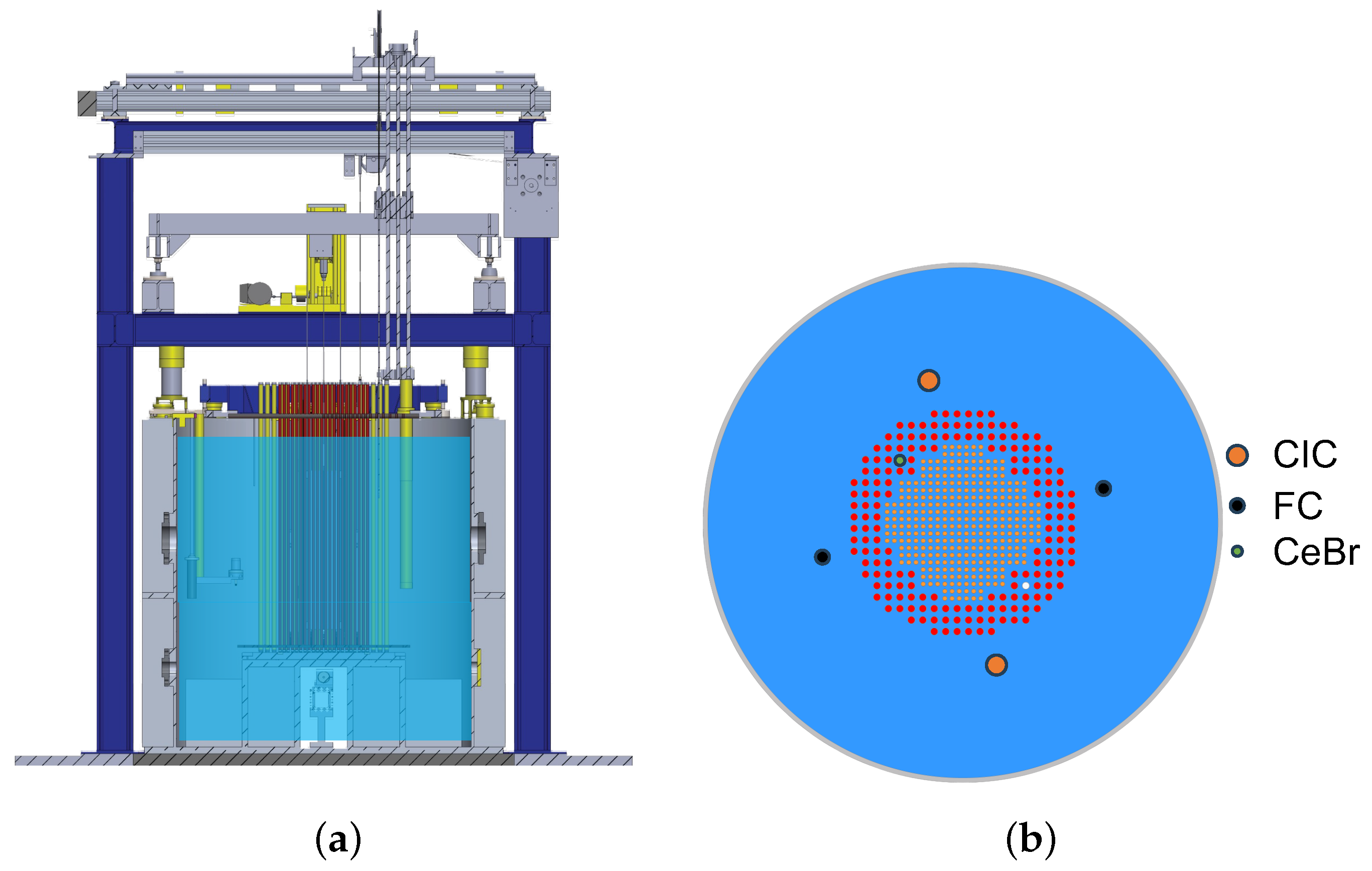

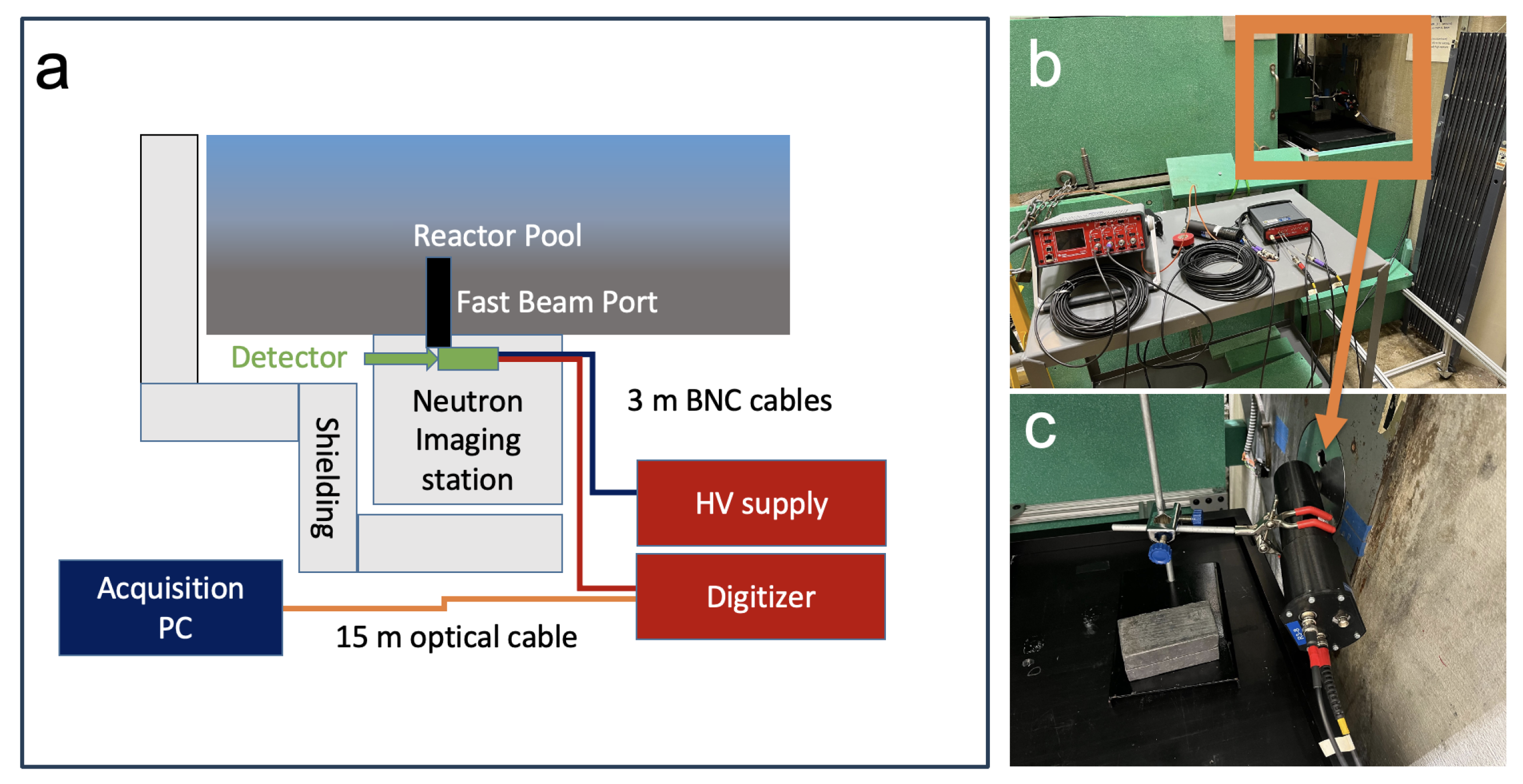




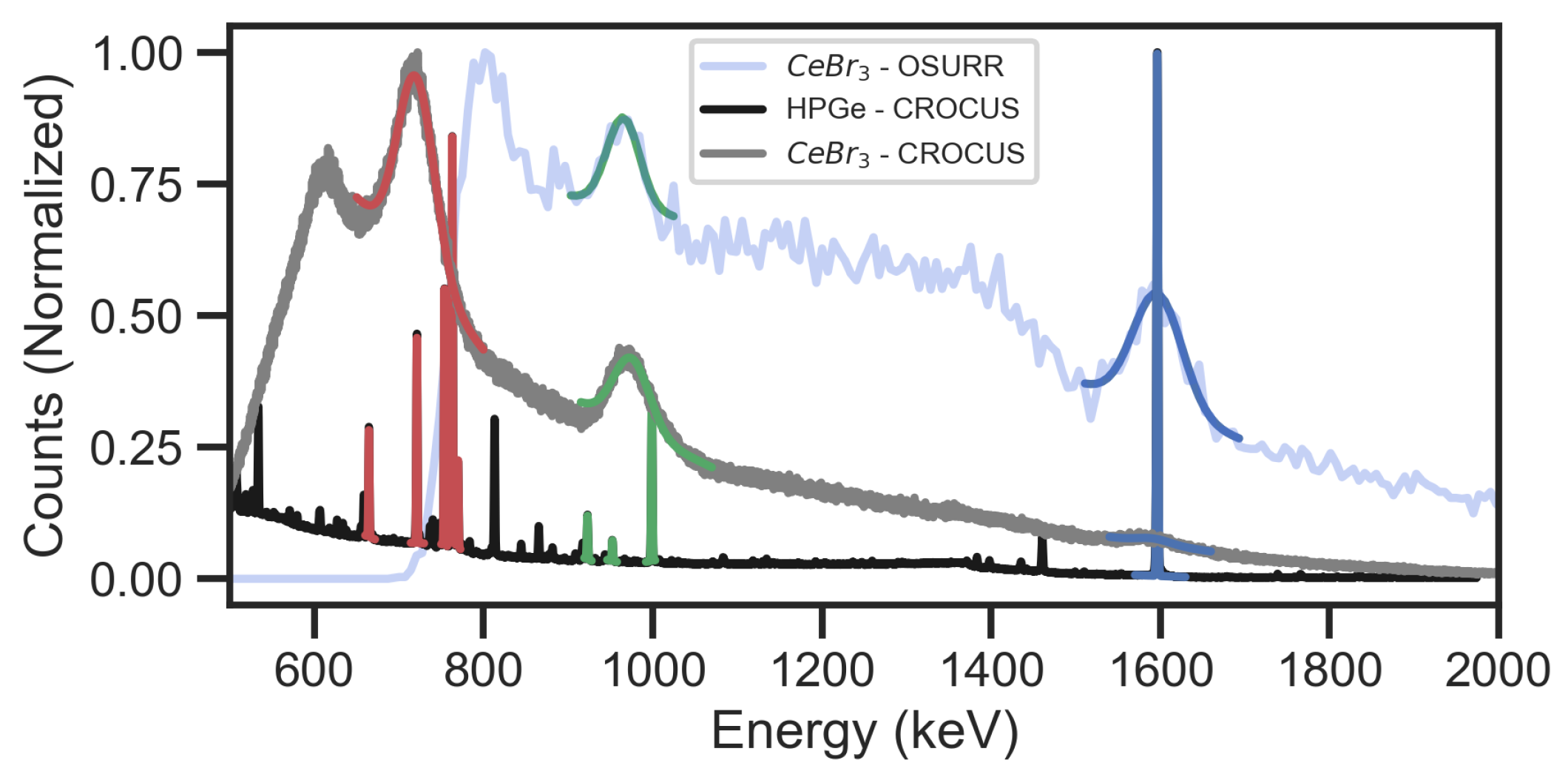

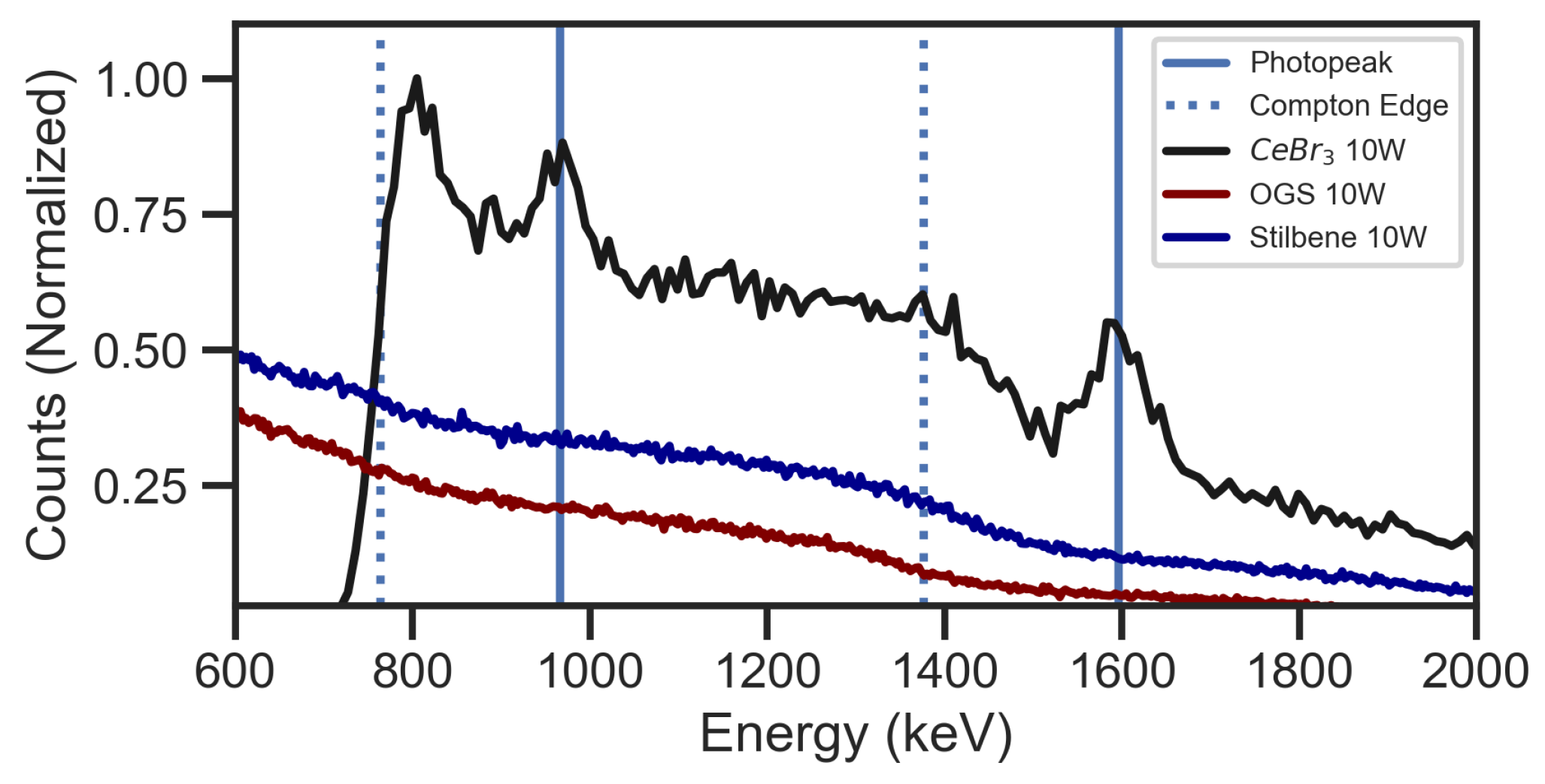
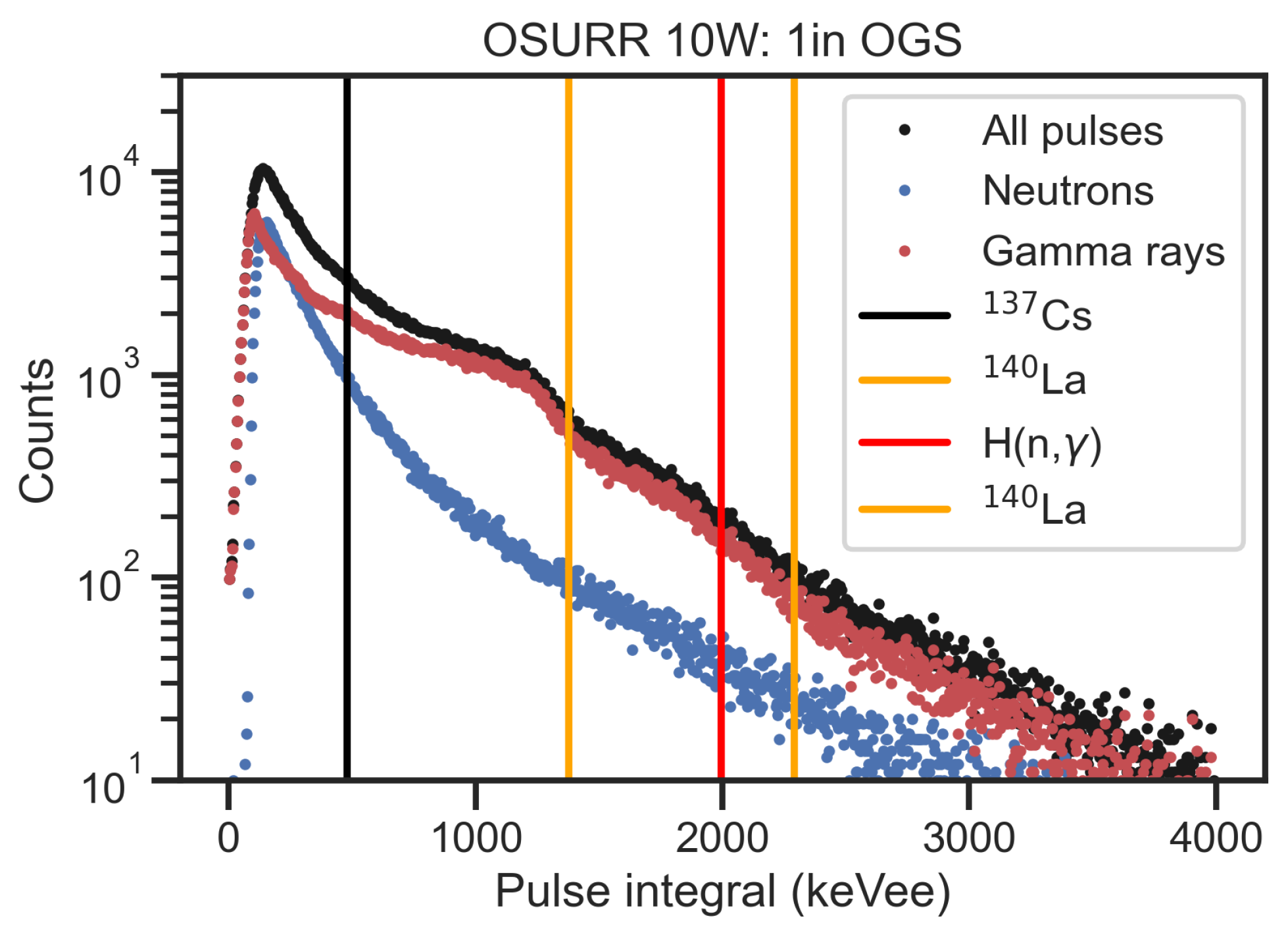
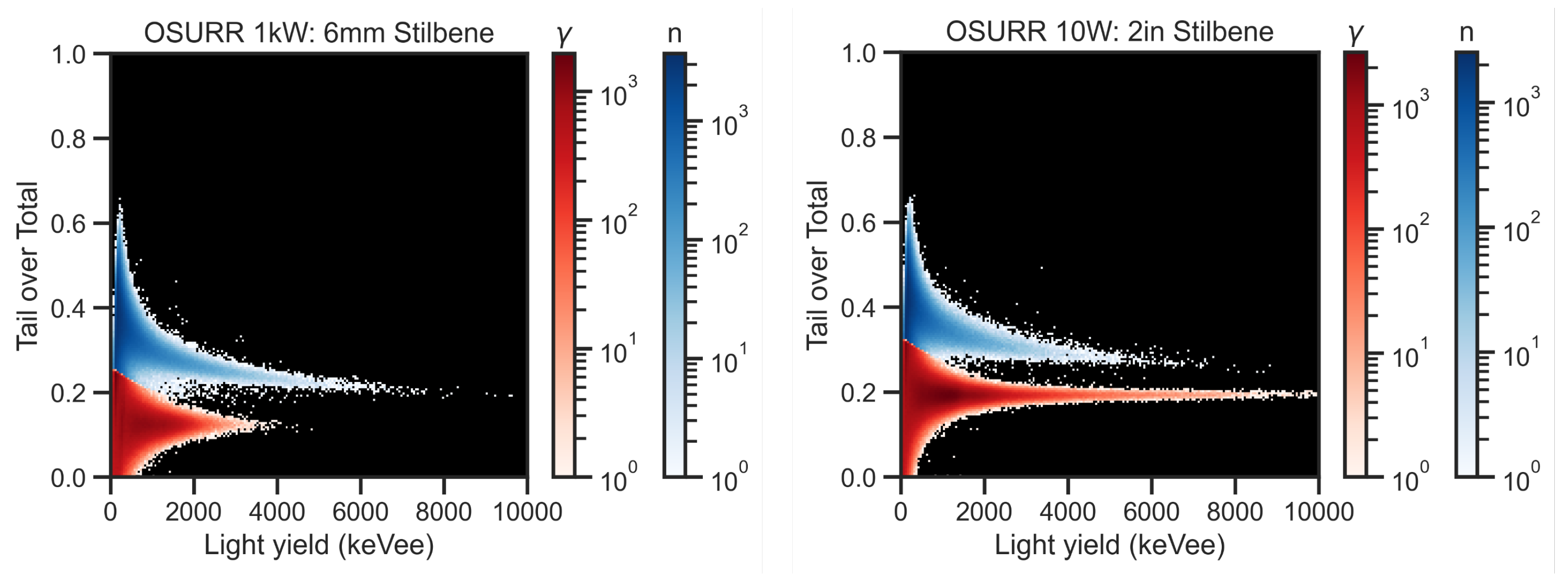

| Energy (keV) | Emitter | Half-Life (Hours) | References | Energy (keV) | Emitter | Half-Life (Hours) | References |
|---|---|---|---|---|---|---|---|
| 50 | 238U | 3.94 × 1013 | [61] | 610 | 103Ru | 9.43 × 102 | [62,63] |
| 93 | Th | n/a | [61] | 630 | 132I | 2.30 × 100 | [63,64] |
| 95 | U | n/a | [61] | 662 | 137Cs | 2.62 × 105 | [63,65] |
| 98 | U | n/a | [61] | 668 | 132I | 2.30 × 100 | [63,64] |
| 109 | 235U | 6.13 × 1012 | [61] | 720 | 117Te | 1.03 × 100 | [63,66] |
| 134 | 144Ce | 6.84 × 103 | [67] | 724 | 95Zr | 1.56 × 103 | [65,68] |
| 143 | 235U | 6.13 × 1012 | [61] | 757 | 95Zr | 1.56 × 103 | [65,68] |
| 163 | 235U | 6.13 × 1012 | [61] | 766 | 95Nb | 8.40 × 102 | [63,68] |
| 185 | 235U | 6.13 × 1012 | [61,65] | 773 | 132I | 2.30 × 100 | [64] |
| 202 | 235U | 6.13 × 1012 | [61] | 816 | 140La | 4.00 × 101 | [63,68] |
| 205 | 235U | 6.13 × 1012 | [61,65] | 847 | 134I | 8.75 × 10−1 | [63,64] |
| 221 | 135La | 1.95 × 101 | [63,69] | 871 | 94Nb | 1.75 × 108 | [63,70] |
| 270 | 137Xe | 6.66 × 10−2 | [71] | 884 | 134I | 8.75 × 10−1 | [63,64] |
| 284 | 131I | 1.92 × 102 | [63,65] | 909 | 89Zr | 7.84 × 101 | [63,72] |
| 288 | 135Xe | 9.10 × 100 | [69] | 925 | 140La | 4.00 × 101 | [63,73] |
| 329 | 140La | 4.01 × 101 | [65,68] | 955 | 132I | 2.30 × 100 | [63,64] |
| 364 | 131I | 1.92 × 102 | [65] | 1001 | 238U | 3.94 × 1013 | [74] |
| 487 | 140La | 4.00 × 101 | [65,68] | 1073 | 134I | 8.75 × 10−1 | [63,64] |
| 497 | 103Ru | 9.43 × 102 | [62,65] | 1132 | 135I | 1.92 × 102 | [63,64] |
| 511 | Annihilation | n/a | [75] | 1205 | 91Y | 1.39 × 103 | [63,65] |
| 523 | 132I | 2.30 × 100 | [64] | 1260 | 135I | 6.60 × 100 | [63,64] |
| 526 | 135mXe | 6.60 × 100 | [63,76] | 1596 | 140La | 4.00 × 101 | [63,65] |
| 537 | 140Ba | 3.07 × 102 | [65,68] | 1779 | 27Al(n,) | 3.83 × 10−2 | [77] |
Disclaimer/Publisher’s Note: The statements, opinions and data contained in all publications are solely those of the individual author(s) and contributor(s) and not of MDPI and/or the editor(s). MDPI and/or the editor(s) disclaim responsibility for any injury to people or property resulting from any ideas, methods, instructions or products referred to in the content. |
© 2024 by the authors. Licensee MDPI, Basel, Switzerland. This article is an open access article distributed under the terms and conditions of the Creative Commons Attribution (CC BY) license (https://creativecommons.org/licenses/by/4.0/).
Share and Cite
Pakari, O.V.; Lucas, A.; Darby, F.B.; Lamirand, V.P.; Maurer, T.; Bisbee, M.G.; Cao, L.R.; Pautz, A.; Pozzi, S.A. Gamma-ray Spectroscopy in Low-Power Nuclear Research Reactors. J. Nucl. Eng. 2024, 5, 26-43. https://doi.org/10.3390/jne5010003
Pakari OV, Lucas A, Darby FB, Lamirand VP, Maurer T, Bisbee MG, Cao LR, Pautz A, Pozzi SA. Gamma-ray Spectroscopy in Low-Power Nuclear Research Reactors. Journal of Nuclear Engineering. 2024; 5(1):26-43. https://doi.org/10.3390/jne5010003
Chicago/Turabian StylePakari, Oskari V., Andrew Lucas, Flynn B. Darby, Vincent P. Lamirand, Tessa Maurer, Matthew G. Bisbee, Lei R. Cao, Andreas Pautz, and Sara A. Pozzi. 2024. "Gamma-ray Spectroscopy in Low-Power Nuclear Research Reactors" Journal of Nuclear Engineering 5, no. 1: 26-43. https://doi.org/10.3390/jne5010003
APA StylePakari, O. V., Lucas, A., Darby, F. B., Lamirand, V. P., Maurer, T., Bisbee, M. G., Cao, L. R., Pautz, A., & Pozzi, S. A. (2024). Gamma-ray Spectroscopy in Low-Power Nuclear Research Reactors. Journal of Nuclear Engineering, 5(1), 26-43. https://doi.org/10.3390/jne5010003






